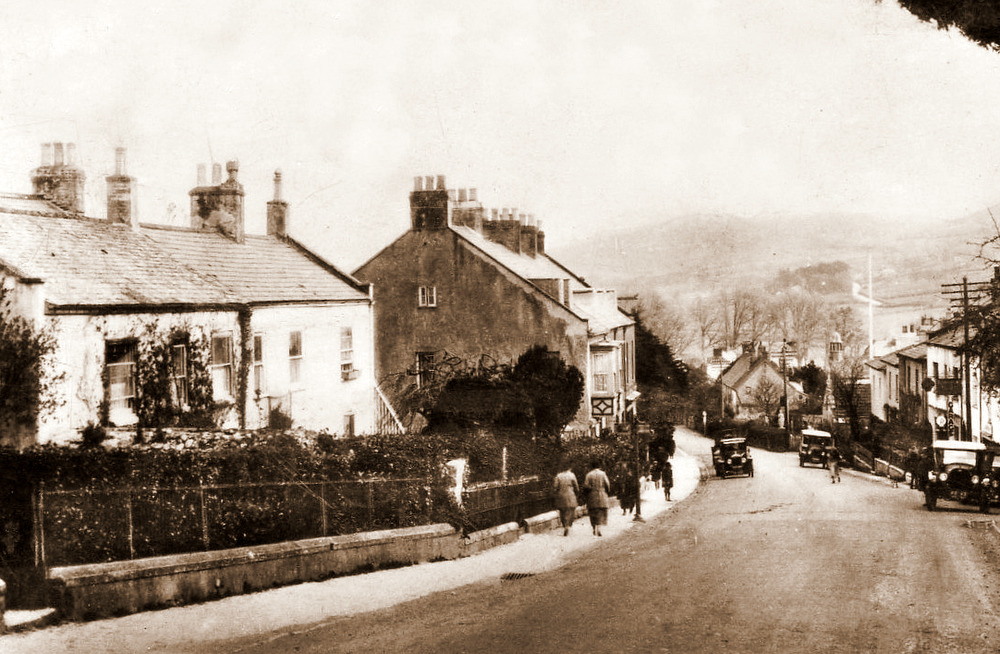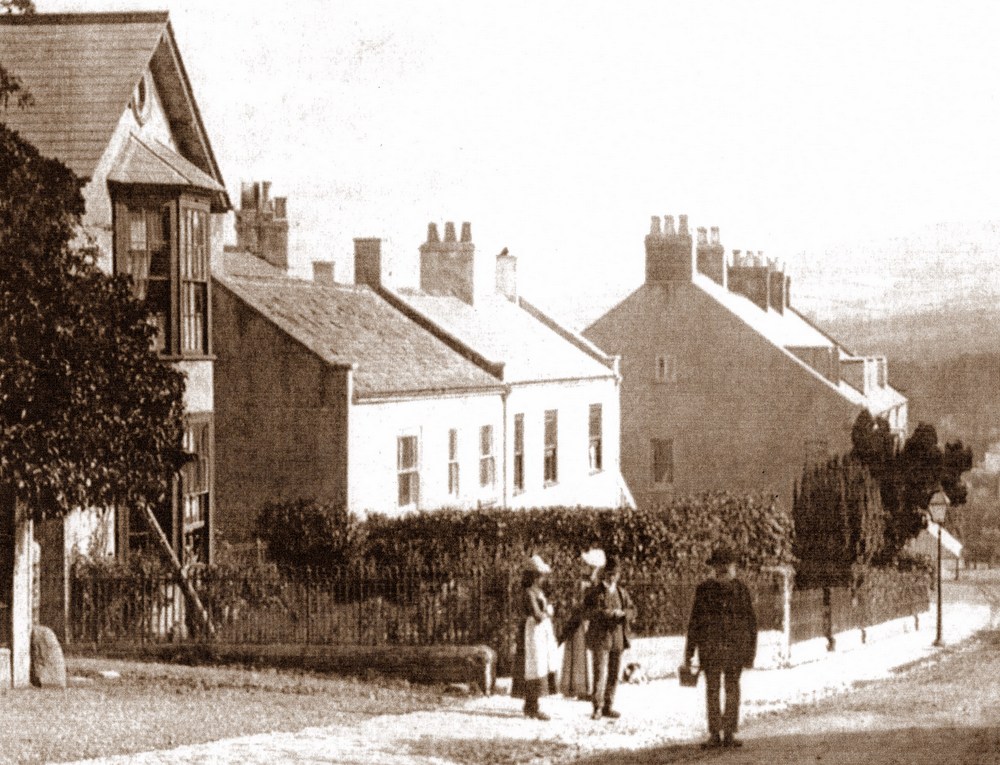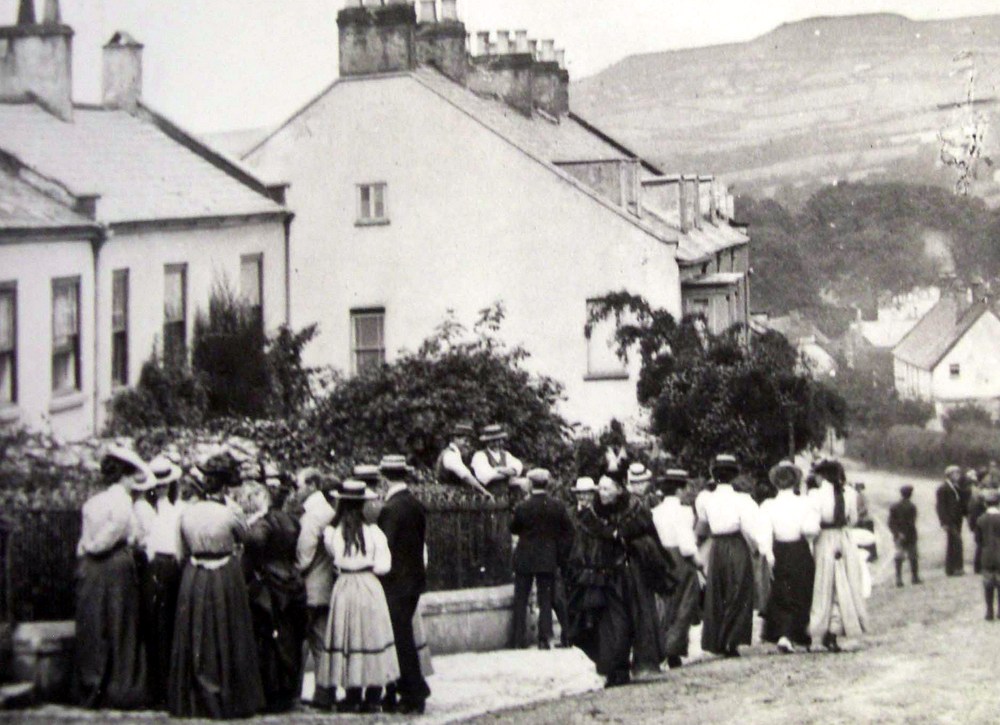
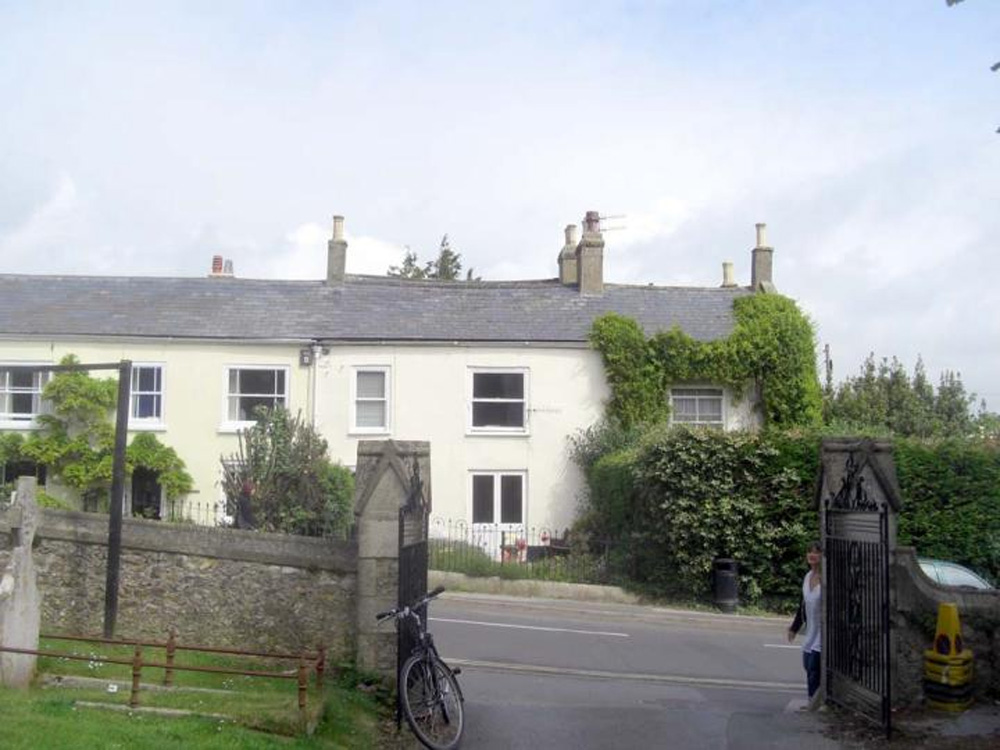
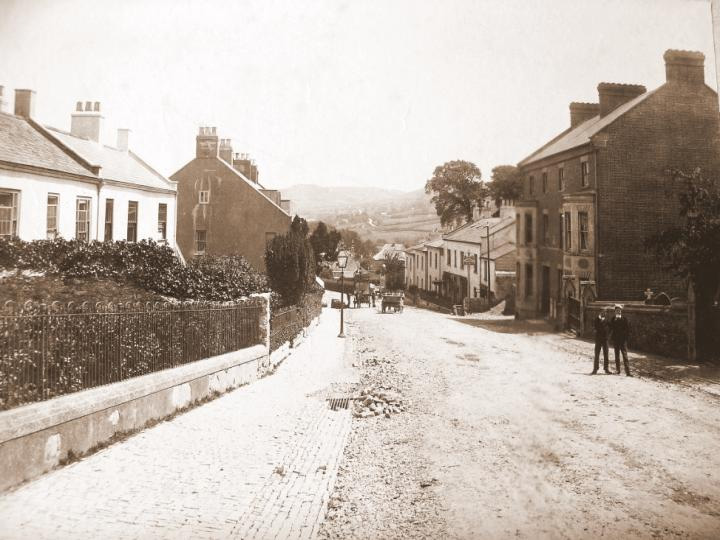
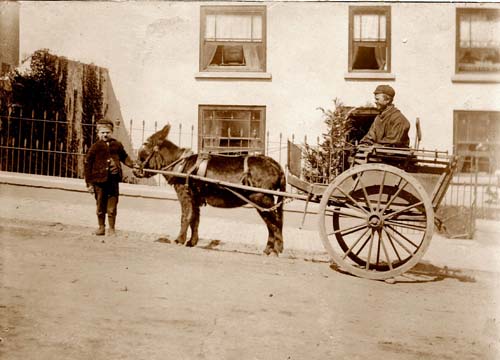
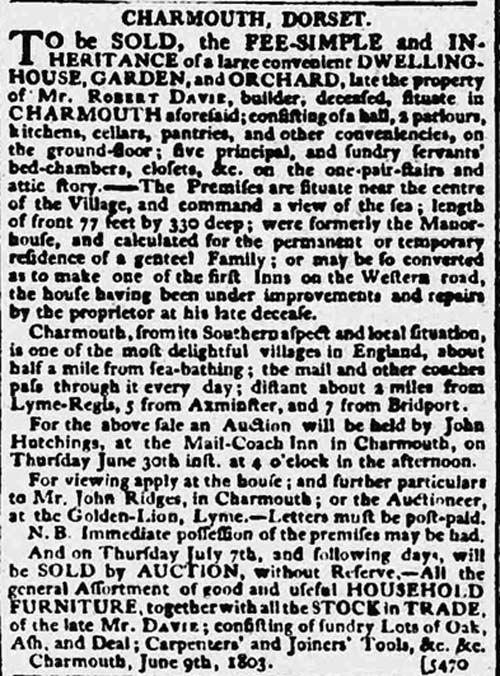
The Manor House in Charmouth is somewhat of a mystery to most people as they are expecting an ancient building near to the Church as can be seen in many of the surrounding villages such as Chideock and Wootton Fitzpaine. Ours is indeed very ancient and is in the proximity of the Church, but is separated by the Street. For it is the long Victorian fronted building directly opposite St. Andrews, now divided into three parts, which was once the historic House owned by the Lords of the Manor of Charmouth for many centuries. Up until recently no images of the earlier building were thought to have existed. The only description being from Colonel Bullen, who once said, “that the house originally was castellated and an old print showing this was destroyed by m y housekeeper as rubbish”. But I was astonished to see a painting by Diana Sperling described as "The view from the Rectory at Charmouth" which was painted in 1828, which clearly showed a section of the original front before being refaced. This picture revealed that it had intricately carved stone surrounds filled with leaded glass. They are very similar to those at Forde Abbey and were no doubt commissioned by Thomas Charde who was the Abbot from 1501 until the dissolution of the Abbey in 1539. He was also responsible for re-facing the Abbots House in the village and rebuilding the Church (1503).
The listing for the Grade 2 building points to the 16 th Century with its roof construction under the present roof and an open fireplace with moulded stone jambs and Tudor-arch head with recessed spandrels. It would definitely have been in Chards time as the subsequent owners of Charmouth, the Petre and Pole families lived in finer houses a distance from the village. There may well have been an earlier building on the site as in 1290 an earlier Abbot had instigated a borough with by burgage plots stretching back from the Street. The house with its fine features was no doubt meant for the use of the Abbot or his representative.
After nearly four centuries of ownership by the Abbot of Forde, the Manor reverted briefly back to the Crown before being bought from Elizabeth I by the Caldwell brothers for just £25 in 1564. They in turn sold it to Sir William Petre, whose family were extremely wealthy and lived in Ingatestone in Essex. Ten years later they were to sell it to William Pole, who lived nearby at Shute, near Axminster. As both families had large estates they would have let the Manor or housed their Steward there. This was to continue until 1648 when the village was at last to have a resident Lord of the Manor living in this house. We can be certain of this as the Hearth Tax of 1663 shows the largest property with six fireplaces being the Manor owned by William Ellesdon. His was an important family of Merchants who had provided Mayors and Members of Parliament on a number of occasions to nearby Lyme Regis. His own father, Anthony had been mayor on three occasions and had also bought the adjoining hamlet of Newlands in 1649 thereby reuniting the two parts of the village. It was William who so nearly succeeded in assisting in the escape of King Charles II to France in 1651 from Charmouth. He was to have two sons, Thomas and Anthony, both of whom appear to live in Charmouth. The eldest Thomas may well have lived at Newlands Manor (now Stonebarrow Manor), which had belonged to the father. Whilst it is known that his brother Anthony was to spend most of his considerable years at the Old Manor opposite the Church. Thomas has left us a detailed inventory of all he owned at the time of his death in 1730 and it details that his last days on the earth were to be spent at his brother's manor house in Charmouth.
Anthony Ellesdon, according to the record on his memorial in the church, was a great benefactor to the village. Besides presenting a silver Chalice and Plate in 1716 and restoring the church in 1732, he also augmented the stipend of the rector with a gift of £200. 'The vestry book contains a copy of the standing Vestry order "Wrote by Counsellor Ellesdon` s own hand "-dated 7th April 1729 concerning the ringing of the bells. Anthony died in November 1737 aged 79 and the manor passed to his nephew Richard Henvil, a Bristol merchant who in due course erected an elaborate memorial to Anthony which was moved from the former church in 1838, as was a large tablet commemorating his re-edifying the church. The Manor House would no doubt have been let as the Henvils also owned the nearby Catherstone Manor house a larger, more impressive building. They also had estates in St Kitts and one branch of the family was to live there. Richard was only to live for a few more years and it was his daughter Benedicta who in 1744 was to inherit the manor. She also owned Catherstone and Newlands and may well have lived in one of the properties. She was to be the Lady of the Manor for the next 35 years and her name appears at times in the records for the village. One of these reveals that in 1771, Thomas Rickard, her Steward was leasing the property on the corner of the Street and Lower Sea Lane, currently known today as the Pharmacy from her for 6d per annum. At a Court Leet held on 5th Oct. 1770 it was stated that there ought to be a pair of Stocks erected within the manor at the expense of the Lady of the Manor. Later in her life she was to marry the Rev. Joseph Durston and live near Gloucester, but they were to have no children and her estate was to go to a distant cousin living in St. Kitts. Francis Phipps Henvill was to own it briefly, but there is a detailed survey of the estate in Charmouth for 1783 showing the “Mansion House with its 3 rods and 25 perches of gardens”. The Estate was auctioned in 1788 and was virtually split in two with the grounds to the north of the Street being described as Backlands, being bought by the Village's Curate, Brian Combe and those to the south known as Sealands by Lieutenant James Warden. The Manor House had a new owner in the shape of Robert Davey who is shown paying 7s 4d land tax on the “Manor House” in the following year. There is a gravestone in the church showing that he was to die in 1803 aged 59 years. The land tax for the following year show that Simeon Bullen is the new owner of the Manor and his family are to occupy it for the next 80 years. Simeon was the grandson of William Bullen of Cathanger in Fifehead, Somerset, who held an Estate under the Wyndham Family in the 17th Century. He was kinsman of Bullen Reymis, brother in law of Wyndham. Bullen Reymiss and Ellesden, helped Lord Berkely to escape after the battle of Worcester, which led Wyndham to come to Ellesden to arrange for the escape of King Charles II. He dies in 1822 aged 75 and leaves the manor to his youngest son, John Bullen. He seems to have divided the house into 3 parts as is shown by the 1841 Tithe Map. The 1851 Census for Charmouth show him as a retired Solicitor originating from Stoke Abbot in Dorset living in the west part and his son Lieutenant Charles aged 39,occupying the other part with his wife Mary. The will for John, who dies the following year reveals that the eastern part, where he was living was to go to his great nephew John Bullen Symes, who added Bullen to his name and became known as Colonel Bullen. The eastern part is to remain with his son, Charles who was in due course to rise to the rank of Captain in the Navy. Charles continued to live there until his death in 1884 and was buried in Charmouth Church where there is a memorial to him. The property was briefly to be occupied by his wife, Mary and inherited by his relation, John Tatchell Bullen of Marshwood Manor. In 1886 he sold this part of the manor to his kinsman, Colonel J.B.S. Bullen who had been living in the other portion for £300. For a few years the Manor was to have just one owner. But in 1889 the Colonel bought the neighbouring Catherstone Estate and sold off the west wing of Charmouth Manor to Miss Mary Ann Miller and briefly rented the rest to Dr. William Kerbey and then to John Gilligham, his Farm Manager. He was to keep ownership until his death in 1938 and two years afterwards his trustees sold it to Reginald Forsey who owned the adjoining Backlands Farm. The family kept the central section and sold off the other part in 1940 to Silvia Cumine. By 1951 Gladys Forsey had bought the remainder from her relation and in due course her son, William ran a Dairy from the premises. There is still a link with this family in the ownership of the local taxi firm, Floyds that continues to be operated at the rear of the Manor House.
The western portion after the long residency by Captain Charles Bullen was bought by Miss Mary Ann Miller in 1889 who is supposed to be responsible for the removal of the beautiful medieval leaded windows and replacing them with the sash windows seen today. It was then purchased it at the beginning of the 20th century by Ernest Nunn and then the Johnstones. It was Mr. Johnstone who started the Charmouth Troop of Scouts in 1914. He also wrote and produced many plays in the Church Hall. Lewis Montgomery Jones then owned it and his mother and sister Nellie occupied the centre part. The father of Lewis had been the village Schoolmaster from 1878 till shortly before his death in 1917.His son Peter Wilson Jones was to live there from 1941 and then Mike Hendrick bought it in 1963. He ran the famous Charmouth Pottery and for a while ran a shop from the premises until the demise of the passing trade with the Bypass. In 2009 he sold it to the Ingrams who after careful restoration now let it as a holiday cottage. Their website www.charmouthmanor.com provides a glimpse into this historic house. Hilary Sharpe and her husband bought the middle section of the property from the Forseys, from where she now runs her Acupuncture practice. The Bullens former stables are at the back of the house and approached by a narrow lane by the side of the garden. The large garden, which would have originally formed part of the 13th Century Burgage plot, has long since been developed. But if one looks closely there are still signs of a once great Manor House within its ancient walls.To be sold, the Fee- Simple and Inheritance of a large Dwelling House, Garden and Orchard, late the property of Mr. Robert Davie,Builder, deceased, situated in Charmouth aforesaid, consisting of a Hall, a Parlour, Kitchens,Cellars, Pantries, and other conveniences on the ground floor,five principal and sundry Servants Bed Chambers,Closets,etc.on the one pair stairs and attic storey.the premises are situated in the centre of the village, and command a view of the sea.Length of front 77 feet by 330 feet deep, were formerly the Manor House, and calculated for the permanent or temporary residence of a Genteel family, or may be converted to form one of the first Inns on the Western Road. The House having been under improvements and repairs by the Proprietor at his late decease. Charmouth from its Southern Aspect and Local situation, is one of the most delightful villages in England, about half a mile from sea bathing. The Mail and other coaches pass through it every day, Distance about 2 miles from Lyme Regis, 5 from Axminster and 7 from Bridport. For the above sale, an auction will be held by John Hutchins, at the Mail Coach Inn in Charmouth on Thursday June 30th instant at 4 o'clock in the afternoon. For viewing apply at the house, and further particulars to Mr. John Ridges in Charmouth, or the Auctioneer at the Golden Lion, Lyme - Letters must be post-paid.
N.B. Immediate possession of the premises may be had.
And on Thursday July 7th, and following days will be sold by auction without Reserve.- All the general assortment of good and useful Household Furniture, together with all the Stock and Trade of the late Mr. Davies, consisting of sundry Lots of Oak, Ash, and Deal, Carpenters and Joiners Tools, Etc. charmouth, June 9th, 1803.

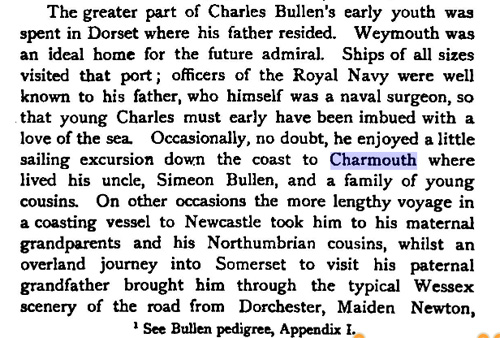
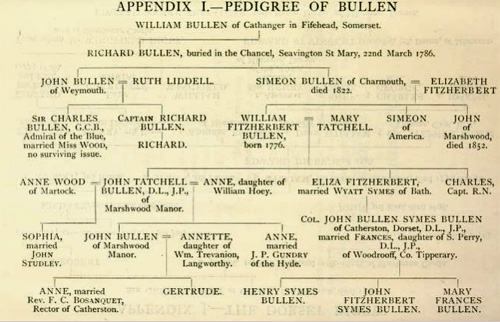
The Family Tree in 1905.
